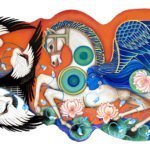Geeta Dave, The Noble Soul (2020). Acrylic on wood; 4 ft. × 8 ft.
The National Performance Network is thrilled to announce the second cohort of the Take Notice Fund, honoring artists of color in Louisiana. NPN envisions a world in which artists of color living and working in the South have the power, resources, and opportunities to thrive. The Take Notice Fund is part of NPN’s Southern Programs and expands upon this critical vision for the South.
The Take Notice Fund is a pilot program awarding $5,000 grants to artists and culture bearers of color living and working in Louisiana. Grant funds are unrestricted and intended to support an artist’s creative practice and/or wellbeing. The fund seeks to allow artists to determine that they need to thrive creatively, professionally, and personally. “This grant recognizes that an artist or culture bearer’s practice is supported from many components of that artist’s life,” says NPN Director of Southern Programs Stephanie Atkins. “It’s not just being in the studio. We give these unrestricted funds so they can determine how to direct those funds, to support what they need to spend this money on so they can get closer to doing this work.”
The Take Notice Fund honors artists throughout Louisiana whose bodies of work represent excellence, dedication to their practices, and contributions to this country’s discourse about racial justice and cultural preservation. Atkins highlighted the awardees’ steady commitment to their work: “The award honors those who have decided, ‘I’m going to commit my life to this artistic practice, to always learning, to observing what’s going on in my community and the world.’ It comes down to excellence—these artists are pushing the needle further. There is work in this cohort that is fresh and unapologetic, that captures where we are right now as a society.”
By focusing on Louisiana, NPN aims to deepen the pool of direct funding opportunities for artists in our state, and hopes to develop the Take Notice Fund into a long-term annual grant program. With generous funding from the Ford Foundation’s Creativity and Free Expression program, the Take Notice Fund brings resources directly to creative practitioners. “I’m just proud that NPN is committed to supporting BIPOC artists and that a national funder like the Ford Foundation is helping us do the work,” said Atkins. “I’m just proud of it.”
Take Notice Fund is a program of the National Performance Network and is supported with funding from the Ford Foundation’s Creativity and Free Expression program. As part of an explicit commitment to the American South, the Ford Foundation has provided more than $175 million since 2016 to Southern organizations “who are advancing justice at a moment of historic opportunity.”
“The stories we tell, and the art we create, help us understand our world and make connections to others. Yet the stories we hear the most still disproportionately favor and represent a select few. By lifting up underrepresented or unheard voices, we can strengthen understandings of human complexity.”
–Ford Foundation
Creativity and Free Expression Overview
Introducing the 2022 TAKE NOTICE FUND AWARDEES
Click an artist's name to see more information.
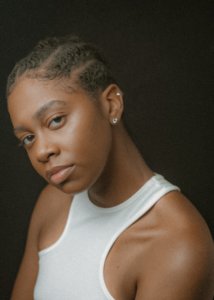
Jazz D’Miracle in Shreveport, LA (2021). Photo: Jazz D’Miracle Photography.
Jasmin Anderson / Jazz D’Miracle (Shreveport)
“My name is Jasmin Anderson. I am a film director, writer, and DP from Shreveport, Louisiana. I am also the owner of Jazz D’Miracle Studios, a full-service film production company. Film has inspired me on many different levels. As a child, I remember endlessly watching the television, falling asleep, and recreating my own interpretation of everything I saw. I never said much, but I wrote a lot, and back then I couldn’t fathom that my imagination would propel me to the heights I have achieved today. Making the decision to become a full-time filmmaker was terrifying at first. I was reassured when my first short, Without Rhyme or Reason, received an award at the 2021 Europe Film Festival. My knowledge of cinematography thus far has been self-taught through lived experience, but I’m also operating within my gift. Walking in my purpose has definitely made room for me, and I’m hoping that my journey inspires others to do what they love.”
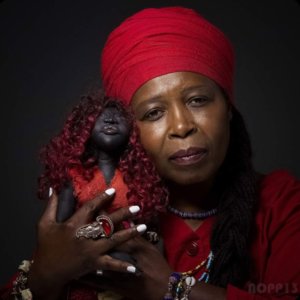
Photo: Rukiya
Elenora “Rukiya” Brown (New Orleans)
Born in Chicago with Louisiana Chahta Indian roots, Rukiya is a mixed-media artist known for doll sculptures, quilts, and ceramics, as well as a Black Masking Indian culture bearer. She became aware of her capacity to create at a young age. Rukiya designed clothes for herself and her friends, created soft-sculpture dolls as a form of self-expression and stress relief, and started quilting as a hobby to document the enslaved. Her narratives blend African traditions, Native American folklore, and contemporary history. Rukiya started masking Indian as another way to express herself while paying homage to the centuries-old cultural tradition. Rukiya’s suits are highly sought after. Her “White Buffalo Calf Woman” suit was acquired by the Musée du quai Branly – Jacques Chirac, in Paris, France. “When Black People Could Fly” was acquired by the New Orleans Museum of Art. “I am the First Gold the First Diamond, I am the Living Earth” is a part of Ohio State University’s collection.

Juicebox P. Burton. Photo: Keli Reule.
Juicebox P. Burton (New Orleans)
Juicebox P. Burton (they/she) is a Black, genderfluid multidisciplinary artist living in New Orleans. She is a world-builder who frames narratives of trauma in the context of horror and sci-fi in order to heal the collective spirit of the Black community. Their work gains its power from its self-taught nature, fostering the collaboration of other creators of color/Black creators whose collective story combats the aristocratic gatekeeping of the mainstream art industry. Juicebox is co-owner of Studio Lalala, a Black and trans mixed-media production company that redistributes resources to marginalized folks. In 2022 Juicebox was awarded the New Orleans Film Society’s Emerging Voices Directors Lab grant, and their “Street Pulse Beat” video received the award for Best Cinematography and Internet Content at the New Orleans Black Film Fest. They are slated to present their work Demarcation at the Southern Exposure Art Gallery in San Francisco.
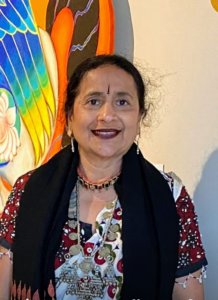
Photo: Geeta Dave
Geeta Dave (Prairieville)
“My paintings are a reflection of my childhood. From a young age, I had a special relationship with nature and its elements that stayed with me all my life. Like every middle-class household I had a simple life, and my friends were parrots, peacocks, and other birds and animals. That unspoken friendship was my little world. At a very young age I got the international World Wildlife award for my painting. After I finished my Master of Fine Arts degree in Creative Painting, I had the opportunity to work on several murals in India, including one at the Gandhi Museum. I have been working as an artist and a teacher in the US for thirty years creating public art and teaching young minds. Throughout my life, I have done many cultural art projects, participated in national and international art exhibitions, and received national and international honors and awards for my work.”
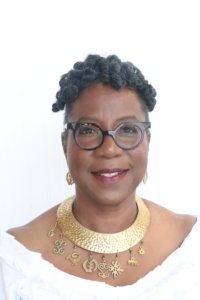
Freddi Williams Evans, 2019 Grand Griot, 19th Annual Maafa Commemoration. Photo: Peter Nakhid.
Freddi Williams Evans (New Orleans)
Freddi Williams Evans is internationally recognized for her scholarship on Congo Square. Her book Congo Square: African Roots in New Orleans, the first comprehensive study of the location, received the 2012 Louisiana Humanities Book of the Year Award. Her research and advocacy influenced the 2011 New Orleans City Council Ordinance that changed the name of the location from Beauregard Square—named after Confederate General P. G. T. Beauregard in 1893—to Congo Square. Her book Come Sunday: A Young Reader’s History of Congo Square received the Independent Publisher Book Awards’ Bronze Medal in 2018 and was a finalist for the 2018 Next Generation Indie Book Award. She has published numerous essays and presents widely on the historic landmark. She is also the author of award-winning books for children, including Hush Harbor: Praying in Secret, The Battle of New Orleans: The Drummer’s Story, and A Bus of Our Own.
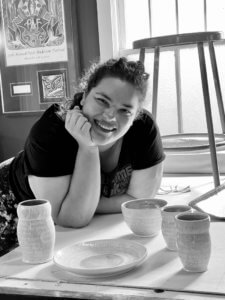
Andrea Garcia posing with Ain’t It Strange the Things We Keep Tucked In Our Hearts Dinnerware in New Orleans (2022).
Andrea Garcia (River Ridge)
Andrea Garcia is a production potter by day, single mother by night, and ceramics sculptor on the weekends. Andrea found her passion for clay many years ago, but without the means to fund undergraduate study, she carved her own educational path, apprenticing with local clay professionals: production potter Kate Tonguis, sculptor Susan Bergman, and most recently ceramist Rachael DePauw, with whom she won the 2020 Studio Potter Grant for Apprenticeship, to further the ideals and traditions of Newcomb Pottery. Andrea has participated in workshops with top artists in the field, including Rene LoPresti and Roberto Lugo. She has been awarded a number of scholarships to Penland School of Craft in North Carolina, as well as a residency with Companion Gallery in Humboldt, Tennessee, where her work has been included in their invitational shows Text Messages II and Last Call VII. She was awarded “Best Set” in Companion’s Last Call V.
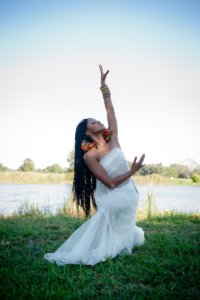
Photo: Gason Asykin.
Jarrell Hamilton / De La SouL Dance Co. (New Orleans)
Jarrell Hamilton is a mother, artistic director, choreographer, writer, creative altruist, entertainer, educator, and founder of JHINC. Hamilton holds a Master of Fine Arts degree from Tulane University in Interdisciplinary Studies (Choreography and African American Studies with a specific focus in Afrodiasporic spiritual traditions) and a Bachelor of Fine Arts in Dance Performance from Southern Methodist University/ Meadows School of the Arts. Hamilton is a seven-time Big Easy Classical Arts Award nominee, 2018 Best Ensemble (Ain’t Misbehavin’) winner, 2016 Best Modern Presentation winner, and 2013 winner for Best Contemporary Choreographer. She is an honoree of the United States President’s Committee on Arts and Humanities Coming Up Taller Award, 2020 National Performance Network Southern Artists for Social Change, and Delta Sigma Theta Sorority’s Artie Award. Recent credits include: City of a Million Dreams documentary film, A House That Will Not Stand (Le Petite Theatre), NAACP Youth Arts Competition, and Tall Girl (Netflix).

LaTonya Jackson
LaTonya Jackson (Shreveport)
“I am an author-illustrator and art educator with a fine arts specialty in graphite drawing and multimedia collage. In 2020, when my life abruptly slowed down, I pivoted toward the pursuit of my lifelong dream of working full-time in the field of children’s book publishing. To that end, I taught myself digital drawing and editing. I made my professional illustrator debut in May 2022 with author Dr. Esau McCaulley’s picture book Josey Johnson’s Hair and the Holy Spirit (IVP Kids). Buddy’s Missing Piece, my authorial debut, is currently under contract with a notable independent children’s book publisher (TBA). I am a maker at heart and the mother of one imaginative little boy whose quirky antics beg to be written and shared with others. I aim to bridge connections and build communities between youth from all corners of the world by acknowledging and affirming the stories that shape their individuality.”
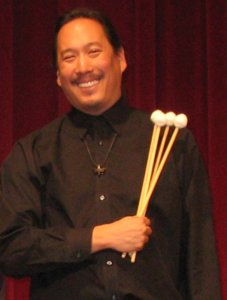
Mendel Lee, post nienteForte concert (2011).
Mendel Lee (New Orleans)
Mendel Lee (he/him, b. 1975) is a composer whose percussion works have been praised as “unique additions to the repertoire.” Lee’s career oscillates between composition/artistic entrepreneurship and music education/pageantry arts. A passionate new music advocate, Mendel is the founder and executive director of nienteForte Contemporary Music, a new-music presenting series based in New Orleans. He is also the co-founder and an executive team member of Toolbox Sessions, an organization whose mission is to connect composers and orchestrators with experienced new music performers and collaborators to delve into effective writing for their respective instruments and voices. He is committed to strengthening collaboration between composers, performers, and audiences to show that new music can be for everyone.
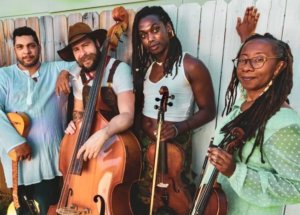
Les Cenelles. Left to right: Joseph Darensbourg, Peter J Bowling, Demi, Denise Frazier.
Les Cenelles (New Orleans)
Les Cenelles is a research-based ensemble centering the act of culture preservation by recontextualizing the diversity of African-descended, ancestral folk music to fit environmental concerns, social justice, dreams, and interpersonal relationships from the past, present, and future. This often includes composing works with spoken word and lyrics in Kouri-Vini, Portuguese, and Spanish. Their focus is the Creole diaspora, including a special focus on Louisiana Creole communities. Les Cenelles coalesced around a question: What is creolité? Finding an answer has led them to sourcing education through academic research, including oral histories, traditional, and familial teachings.
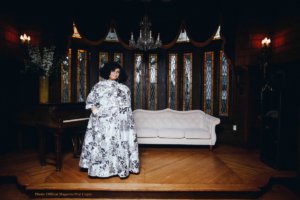
Lilli Lewis. Photo by Noé Cugny for OffBeat Magazine.
Lilli Lewis Folk Rock Diva (Bush)
Trained as an opera singer and classical pianist, Georgia native Lilli Lewis has been a composer, producer, and performer for over two decades. Lewis has carved out space as an African American queer woman of size. Her career reached a pinnacle in 2021 when her album Americana was named a top pick across lists from NPR’s “All Songs Considered” to Rolling Stone. The Folk Rock Diva is a musical polyglot who glides easily between folk, roots, country soul, gospel, and jazz, and has integrated New Orleans traditions by singing lead for Dirty Dozen Brass Band founding member Kirk Joseph’s Backyard Groove. Lewis’s Louisiana Red Hot Records releases include The Henderson Sessions, We Belong, and Americana.
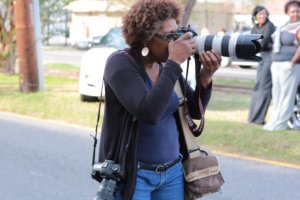
Chandra McCormick on the streets of New Orleans at work shooting her 35mm camera. Photo: Keith Calhoun.
Chandra McCormick (New Orleans)
“I am Chandra McCormick, born 1957. I’m a documentary photographer living and working in New Orleans for the past four decades. I use photography to provide a visual testimony to the lived experiences of African American life in the US South.”
Since the early 1980s, McCormick has engaged photography as a site of social activism—documenting, illuminating, and conveying the struggles and celebrations of the Black American experience. Whether chronicling religious ceremonies, cultural traditions, the visual histories of the Lower 9th Ward, or tracing the legacies of slavery through sugarcane laborers on plantations, to sweet potato field harvesters, to life at Angola, Louisiana’s State Penitentiary, McCormick’s images bear witness to the social realities of Black life—historicizing and archiving the rich, unique traditions and deep-rooted attributes of Louisiana culture.
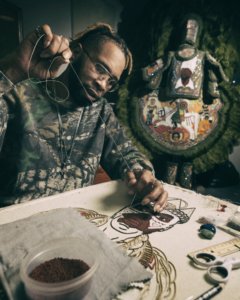
Big Chief Demond Melancon sewing a beaded portrait of Fela Kuti with his 2020 “Jah Defender” suit in the background at his Bywater studio in New Orleans (2021). Photo: Giles Clement.
Big Chief Demond Melancon of the Young Seminole Hunters (New Orleans)
Demond Melancon was born in 1978 and grew up in the Lower Ninth Ward of New Orleans. He was initially taught about the Black Masking Culture by a prolific elder named Big Chief Ferdinand Bigard. Melancon went on to study under Nathanial Williams in connection with a 1993 Louisiana Folklife Apprenticeship Grant. Melancon joined the Seminole Hunters and masked as a Spy Boy for over 15 years under Big Chief Keitoe Jones. In 2012 the elders of the Black Masking community declared that Melancon would then be known as Big Chief Demond Melancon of the Young Seminole Hunters, his very own tribe based in the Lower Ninth Ward of New Orleans.
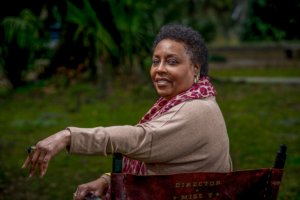
Tommye Myrick (2020). Photo: J. R. Thomason Photography.
Tommye Myrick (New Orleans)
“Theatre, for me, has always been a tool of social activism. I was the recipient of the 2020 New Orleans Big Easy Entertainment Lifetime Achievement in Theater Award. With a strong commitment to theatre and social justice, I joined the famed Free Southern Theater Company while attending Xavier University in New Orleans. After graduating from Xavier, I attended the University of Michigan, where I obtained my master’s degree and immediately began working on my PhD. After moving to New York City, I studied with renowned theater producer, director, and lifelong friend and mentor, Gene Frankel. There I made my NYC stage and directorial debut. After returning home to New Orleans years later, I formed an all–African American women’s theatre company called Voices in the Dark Repertory Theatre. Currently, I am directing New Orleans’s first historical outdoor drama called Le Code Noir, cowritten with Mark R. Sumner, to premiere fall 2022 in historic Congo Square.”
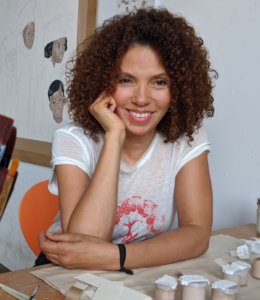
Ruth Owens in her Mid-City studio (2020). Photo: Varvara Degtiarenko.
Ruth Owens (Metairie)
Ruth Owens graduated in 2018 with an MFA from the University of New Orleans after leaving her medical practice of 25 years. She is represented by Jonathan Ferrara Gallery and belongs to the artist collective the Front in New Orleans. Owens’s work is concerned with contributing to and preserving the Black archive, and she uses personal super-8 film references in her painting and video art. Artist residencies include the Joan Mitchell Center, the Addison Gallery of American Art, the Vermont Studio Center, and the Studios at MASS MoCA. She is slotted to attend the International Studio and Curatorial Program in New York in 2023. Her work is in the permanent collections of the Ackland Art Museum at UNC-Chapel Hill, the Addison Gallery of American Art, the Ogden Museum of Southern Art, the Dale Center for the Study of War and Society, and 21c Museum.
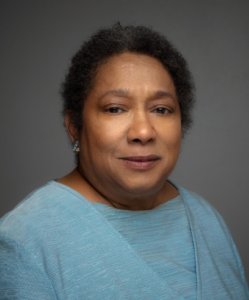
Photo: Gus Bennett Photography 2022
Cecelia “Cely” Tapplette Pedescleaux (Marrero)
“I am a self-taught quilter born in the 7th Ward of New Orleans, Louisiana. My love of fabrics started when I was a child. Quilting is something I love doing because I like creating. My quilts are 75% research, 15% cloth, and 10% heart. In recent years, my quilts have been shown in many venues in New Orleans, the United States, and across the world, including in France and China. I have shown both traditional quilts and art quilts at my church’s annual quilt show; the Contemporary Arts Center, New Orleans; the Jazz & Heritage Gallery; the National Conference of Artists’ annual Martin Luther King Jr Commemorative Art Exhibition; the New Orleans African American Museum of Art, Culture and History; the New Orleans Museum of Art; the Ogden Museum of Southern Art; Southern University at New Orleans; and Stella Jones Gallery. I have demonstrated the art of quilting in the Louisiana Folk live tent at the New Orleans Jazz & Heritage Festival for more than 15 years.”
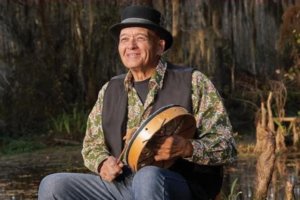
Grayhawk Perkins
L. W. Grayhawk Perkins (Mandeville)
“I'm a musician, composer, artist, storyteller, writer, and woodworker, and I have practiced my culture and tradition for fifty years. I was given the title of Culture Bearer by the State of Louisiana Lieutenant Governor’s office and the United Houma Nation. In addition, I have served as Native American Consultant and Coordinator for New Orleans Jazz & Heritage Festival for 35 years and work as a consultant and performer at the Smithsonian’s National Museum of the American Indian. I speak Mobilian, the Native language the French used here in the early days of Louisiana settlement, which I use in my music. I toured Europe with the Mezcal Jazz Unit of Montpelier, France, and recorded an album in France of compositions in the Mobilian language. I have performed and told stories in schools, universities, museums and libraries across the United States and Europe. I teach creative writing, the art of storytelling, and primitive woodworking to both youth and adult groups.”
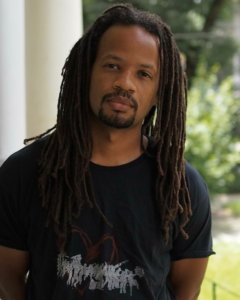
Rontherin Ratliff. Photo: Michael Arcos.
Rontherin Ratliff (New Orleans)
Born and raised in New Orleans, Rontherin Ratliff is a visual artist working in sculpture. Ratliff uses his lived experiences and object association, and works with an understanding of intersectionality, to create art that questions human behavior. He began his artistic career as a self-taught graphic designer and employs the lessons learned from design into his sculptural works both public and conceptual. He is a member of Antenna and Level Artist Collective in New Orleans. His work has been exhibited at venues including the Guggenheim Museum (New York, NY); the Elsewhere Museum (Greensboro, NC); Art Route 2017 (Groningen, Netherlands); the Deering Estate (Miami, FL); Governor’s Island (New York, NY); 516 ARTS (Albuquerque, NM); Iris and B. Gerald Cantor Art Gallery (Worcester, MA); the Ogden Museum of Southern Art (New Orleans, LA); Florida Atlantic University Galleries (Boca Raton, FL); the Newcomb Art Museum at Tulane University (New Orleans, LA); and the Ford Foundation Gallery (New York, NY).
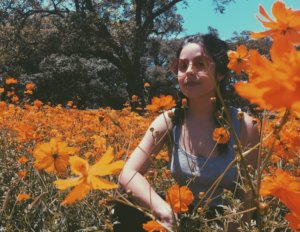
Karla Rosas
Karla Rosas (Cut Off)
Karla Rosas (she/they) is KARLINCHE, a Mexican illustrator and painter based in New Orleans by way of Cut Off, Louisiana. Karla is undocumented, and their art explores immigration as an ongoing mode of being through which we experience memory, family history, land, the body, gender, and the divine. Karla’s art has been featured in the New York Times Style Magazine, the LA Times’s “Latinx Files,” and Salamander Magazine, and has also found homes in places such as UC San Diego’s Undocumented Student Center and the Hood Museum at Dartmouth University. Currently, Karla is working on a chapbook of poems and drawings titled Desahogando: An Undrowning.
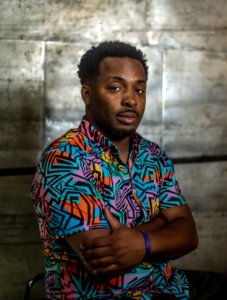
Vitus Shell (2021). Photo: Majestic Depictions.
Vitus Shell (Monroe)
Vitus Shell is a mixed-media collage painter born and currently residing and working in Monroe, Louisiana. His work is geared toward humanizing and normalizing the Black experience, giving agency and visibility to people from his community through powerful mixed-media portraiture that samples, deconstructs, and remixes identity in relation to history, civil rights, and contemporary Black culture. He also co-created the Black Creative Circle of North Louisiana to build an authentic support network for Black creatives. Shell received a BFA from Memphis College of Art in 2000 and an MFA from the University of Mississippi in 2008.
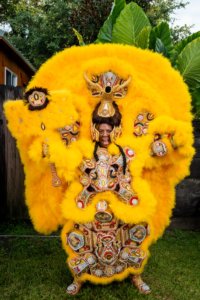
Big Queen Denice in her 2020 suit. Photo: Ryan Hodgson-Rigsbee.
Big Queen Denice Smith of the Monogram Hunters Tribe (Slidell)
Denice Smith started sewing in 2012, making Indian suits for little Queens under the guidance of Monogram Hunters Tyrone “Big Chief Pie” Stevenson. In 2014 she became the first Big Queen of Monogram Hunters, making suits that were as big and beautiful as the Big Chief’s. Since then, she has made a number of suits, including her last one in 2020 just before the pandemic set in. She had planned to mask in 2022 but had to hold off to recover from recent back surgery. She is planning her return to the streets as Big Queen for 2023, for which she will also assist in making suits for a number of members of the Monogram Hunter Tribe.
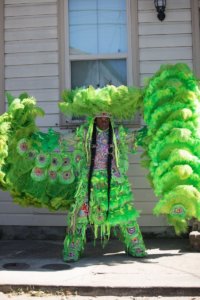
Spy Boy Walter Sandifer III before Uptown Super Sunday in New Orleans (2022). Photo: Andrew Hays Villarreal.
Spy Boy Walter of the Beautiful Creole Apache Tribe (Walter Sandifer III; New Orleans)
Spy Boy Walter Sandifer III is a second-generation masking Indian born into the Creole Wild West tribe in March 1996. “I’m known in the culture for my consistent flow of preserving the tradition by masking Indian every year. My father—who was once a Spy Boy for the Creole Wild West tribe for over 21 years consecutively and is now Big Chief of his own tribe (the Beautiful Creole Apache)—introduced me to the sewing techniques at 11 years of age. Ever since then, I have been turning heads and dropping jaws with my unique art sense and singing skills. I have performed onstage at the New Orleans Jazz & Heritage Festival singing with my former tribe for years, while also holding beading classes for youth and teaching the drumming rhythm of Masking Indians in local schools to preserve the unique culture and tradition of New Orleans, Louisiana.”
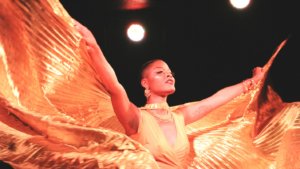
Synamin Vixen performing Oshun at Carnaval Lounge in New Orleans. Photo: Steff Katt.
Synamin Vixen (New Orleans)
Synamin Vixen is a writer, educator, Black Studies scholar, singer, and choreographer. She has more than 25 years of dance experience locally and internationally, and graduated with a Bachelor of Arts in Black Studies and Dance Composition from Swarthmore College. Recently, she has been studying Afro-Diasporic herbal and traditional care practices, reiki, and sex doula work. With a wide range of experiences, Synamin explores how all of these different artistic interests live in one body and influence each other.
Her choreography sparks conversations around identity and social memory. Much of Synamin’s work explores how individuals relate to and influence groups, and how our narratives of similar events can differ greatly based on our lived experiences. Her work in burlesque (on and off stage) focuses on the body as a sensual site of transformative healing. In 2021, she released her first book of ancestral poetry entitled Daughter of a Nymph Divine.
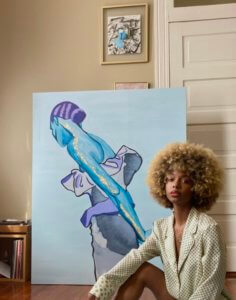
Gabrielle Tolliver next to painting AIM at personal studio (2021). Photo: Gabrielle Tolliver.
Gabrielle Tolliver (New Orleans)
“I am a New Orleans native who has had the privilege of training with artists within the city. New Orleans’ unique nature has allowed me to be surrounded by various artforms throughout my life. The blend of music, motion, and visual art gives us a safe space to express and preserve our history, present, and desired future. I believe building community through the arts is a critical contribution we as culture bearers have the responsibility of carrying. In my independent work, I like to focus on environmental resilience and our impact on the wellbeing of the world around us. When we look at creating through the lens of community impact, it can open up a broader conversation about the environments these communities develop in. If the place a community is formed in suffers from a lack of care, the relationships within these spaces suffer as well.”
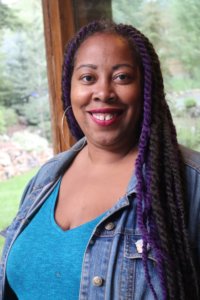
Angela Tucker. Photo: Mariana Sheppard.
Angela Tucker (New Orleans)
New York City–born New Orleans transplant Angela Tucker is a director, writer, and Emmy Award–winning producer. Her recent film projects include The Trees Remember, a Webby Award–winning series about Black women finding connection in the outdoors, and A New Orleans Noel, an upcoming Lifetime film starring Patti LaBelle filmed in Mississippi and Louisiana. She produced Belly of the Beast, a documentary feature about the legacy of forced sterilizations in California (PBS’s Independent Lens) and directed All Skinfolk Ain’t Kinfolk, a short about the 2017 mayoral election in New Orleans (PBS’s Reel South).
A programmer for New Orleans Film Festival, Tucker is a Sundance Institute Fellow, a William Greaves Fund Fellow (Firelight Media), and a member of the Academy of Motion Pictures Arts and Sciences. She holds an MFA in Film from Columbia University and a BA in Theater and African American Studies from Wesleyan University.

Monica Tyran (2019). Photo: Demiur’s Photography / Jourdan Barnes.
Monica Tyran (Metairie)
Monica Tyran is a printmaker and screenprinter, born and raised in New Orleans. Monica began her artistic journey in 2004 as a youth artist at Young Aspirations Young Artists, Inc. (YAYA), which led her to pursue a career in arts administration. Balancing both her creative practice and administrative work, Monica built her printmaking and painting skills and techniques through an undergraduate degree in Studio Art and attending numerous continued studies programs in screenprinting, letterpress, bookbinding, and artists’ books. Monica’s work deals with identity, imagination, and formative imagery connected to her upbringing and family memories; it has been exhibited at the New Orleans Community Printshop; Contemporary Arts Center, New Orleans; and Stella Jones Gallery.
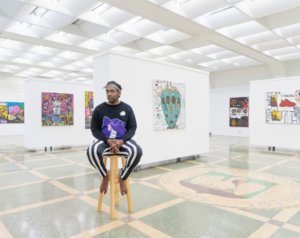
Artist in studio. Photo: Paul Castello.
John Isiah Walton (New Orleans)
John Isiah Walton is a New Orleans–born artist whose neo-expressionist works are internationally recognized for their commentary on race, class, identity, and current events. He conjures an absurdist urbanscape that portrays behind-the-scenes looks at the past of the city where he grew up. Walton is a founding member of the Second Story Gallery and Level Artist Collective. He was the first African American member of The Front collective. His art has shown at Art Lab Akiba (Tokyo); Atlanta Contemporary Biennial; Ogden Museum of Southern Art (New Orleans); the permanent collection of the New Orleans Museum of Art; Ohr-O'Keefe Museum of Art (Biloxi); P339 (Brooklyn); and more. His residencies include the Macedonia Institute (Chatham, New York) and the Joan Mitchell Center (New Orleans). He has collaborated to produce a sculptural work of public art for Juneteenth, lectured about his artistic journey to numerous learning institutions, and served as co-chair for area fundraising events.
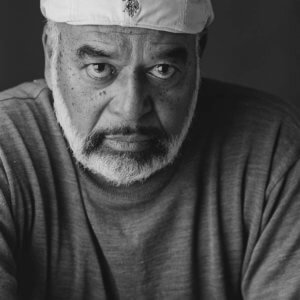
Eric Waters. Photo: Julie Yarbrough.
Eric Waters (New Orleans)
As a photographer, Eric Waters has documented the African Retentive Culture (Culture Bearers) of New Orleans for over forty years. Waters co-authored the book Freedom’s Dance: Social, Aid and Pleasure Clubs in New Orleans with Karen Celestan and was a 2018 Joan Mitchell Center Artist-in-Residence. He founded Ebon Images to chronicle and catalog the body of work of Marion J. Porter, one of New Orleans’s iconic photographers, whose images appear in Reflections in Black by Deb Willis. Waters continues to document the Culture and its Bearers and has gained the respect and trust of the New Orleans cultural community.
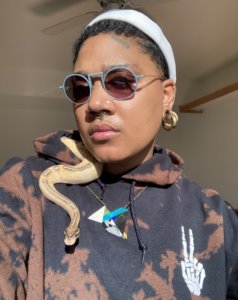
Lorna Williams.
Lorna Williams Studios (New Orleans)
Lorna Williams was born in 1986 in New Orleans, Louisiana. She received a BFA from Maryland Institute College of Art in 2010. She also studied at New Orleans Center for Creative Arts and School of Museum of Fine Arts, Boston. In 2009, they attended the Norfolk Program at Yale University. Williams’s work has been exhibited at the New Orleans Museum of Art; the Studio Museum in Harlem; Montserrat College of Art; and the University of Massachusetts. Her work has been reviewed in the Wall Street Journal, Art in America, the New York Times, Hyperallergic, New American Paintings, FLATT, and the Boston Globe. They are the recipient of numerous awards and recognitions, including an Art Matters Foundation Grant, the Leeway Foundation Art and Change Grant, and an Ellen Battell Stoeckel Fellowship. She has been nominated for and accepted into residencies with the Joan Mitchell Foundation and Rauschenberg Foundation. Artworks included in the collections of Beth Rudin DeWoody, A. C. Hudgins, Peggy Cooper Cafritz, Arthur Lewis, the New Orleans Museum of Art, and the 21c Museum. Williams lives and works in New Orleans, Louisiana.
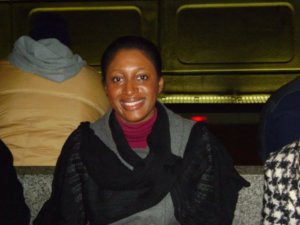
Courtney Young in Washington DC (2017). Photo: Lindsay Young.
Courtney C. Young (Lafayette)
Courtney Young is a writer of fiction, screenplays, popular culture, and creative nonfiction. She is a recipient of residencies from Willapa Bay AiR, Vermont Studio Center, Faber, the Hambidge Center, Bainbridge, and Chateau D’Orquevaux. She is the founder of the Mae Fellowship, an annual virtual program that provides financial and professional support to women and nonbinary writers seeking to publish their first book. Her current projects include completing both her first narrative feature, entitled This Savage Life Makes Us Hard to Kill, and her first collection of short stories, entitled Scar Tissue of the Extraordinary. A graduate of Spelman College and New York University, she received her BA in English with a minor in Management and her MA from the Gallatin School of Individualized Study. She was born, raised, and currently lives in Lafayette, Louisiana.
